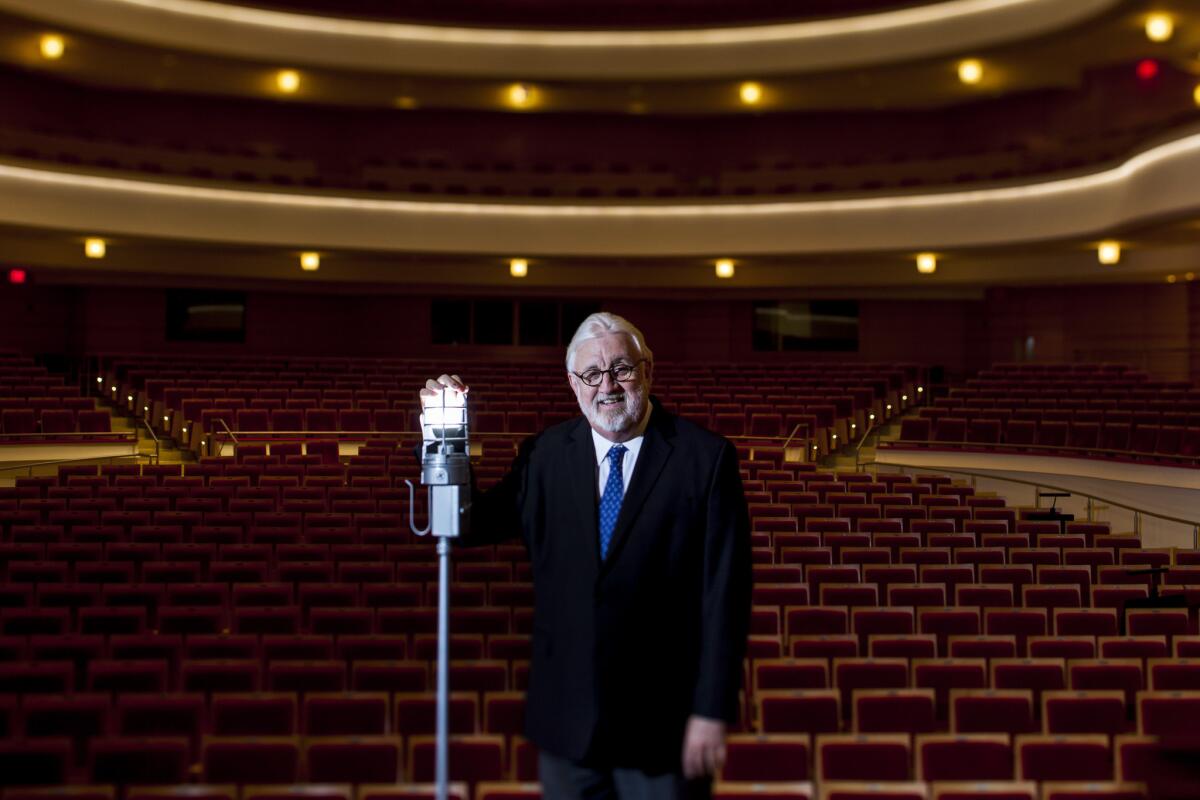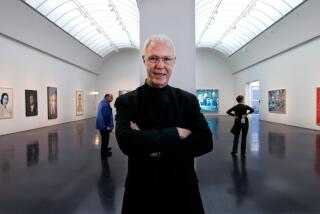Dean Corey of Philharmonic Society of Orange County still full of ideas

Weirdly appropriate, “Thanks for the Memories” is playing in the background of an Asian bistro in South Coast Plaza where Dean Corey and his wife, Kaly, have ordered a late afternoon bottle of white wine.
Life is good. The 67-year-old president of the Philharmonic Society of Orange County is retiring next month and moving to a small village in the south of France.
The memories are good. The arts, and classical music in particular, should never again be the same in Orange County thanks to Corey’s 21 years of advocacy. He has made the Segerstrom Center for the Performing Arts and surrounding venues into destinations not only for the world’s great orchestras, ensembles and musicians, but many a venturesome avant-gardist as well.
He has fought a number of battles in doing so. He has wooed donors day and night. Keeping classical music alive isn’t getting any easier.
The reports of orchestras, opera companies and classical record labels in trouble inevitably get all the attention. But as Corey looks up from his glass with a satisfied smile, he insists he is not worried about the future.
“The death of classical music,” he announces with a hint of a Southern twang, “is classical music’s oldest tradition,” paraphrasing the late pianist and scholar Charles Rosen.
A Yale-educated former French horn player from Arlington, Texas, with a folksy, funny, charming, wry manner, Corey is one of the arts leaders who has explored ways to find modern meaning for today’s audiences.
“Classical music is beloved by millions and millions of people,” Corey says. “Models change. We just need a new model.”
And for Corey that model is not so much thinking outside the box as simply making the box better.
He believes in quality and has wrested money from a wealthy community to obtain the best orchestras money can buy, such as the Vienna Philharmonic, the Berlin Philharmonic, often to the envy of L.A. His most ambitious seasons have made the Orange County Performing Arts Center almost a Carnegie Hall West.
Just as important, Corey has been cheerleader for massive musical change.
“One of the first things I did here,” he says about his first season in 1993, “was plan to bring the Kronos Quartet as soon as I could. I wanted to bring them every season, forever.” In 1999, Corey turned his passion for presenting new work into the Eclectic Orange Festival, making the Philharmonic Society at the time the most progressive presenter in Southern California.
In advocating such work as Steve Reich’s controversial Middle East video opera, “The Cave,” and Mikel Rouse’s rock ‘n’ rollish television opera, “Dennis Cleveland,” and co-commissioning Philip Glass’ grandest orchestral work, his millennial Fifth Symphony, the Society was also a Brooklyn Academy of the Music west.
And with what must be the greatest irony in today’s music administration business, Mitch Miller, a populist’s populist, inadvertently made him do it.
Corey began his career as a New York freelance musician in the early ‘70s, playing in the New York City Ballet Orchestra and loving it. But when his wife at that time wanted to return to Texas, he wound up in Dallas working in his father-in-law’s grocery firm helping open new stores.
“I hated it,” Corey recalls, “but the experience helped me see the for-profit side of things.”
Eventually, he began playing in the Fort Worth Symphony, where he was also drafted to help sell tours. One thing led to another, and he found himself running orchestras in Chattanooga, Tenn.; Jacksonville, Fla.; and finally Rochester, N.Y.
Once the prosperous home of the Eastman Kodak company, Rochester was on a downturn in the late ‘80s, and so was its orchestra.
“It was sort of doomed to failure,” Corey says, “and I hurried it along by getting into an argument with Mitch Miller,” who was king of pops concerts, had had a popular TV show in the ‘60s, “Sing Along With Mitch,” and was a powerful record producer.
“Seeing Mitch’s audiences had slightly declined,” Corey continues, “I thought I’d cut out one of his concerts and bring someone else in. I didn’t want to overexpose him. But he took unbelievable offense to this. I mean he just went crazy.”
At a Christmas pops concert, Miller told the audience that he had never been so insulted in his life and that he was never coming back to Rochester.
A newspaper reporter asked Corey for a comment, and he said that this seemed like an arrogant thing for Miller to do. That became a headline. Miller denounced Corey on local television news. The media turned on Corey. Editorial cartoons showed Corey crashing his head between cymbals and tearing the strings out of a piano.
When it got to the point that the only person getting more local coverage was a serial killer, Corey resigned, telling the board, “What you’re going to be getting rid of is an extraordinary experience, which I’ll take with me.”
He describes that experience as an education in how to handle the media and not avoid it. “They’re in the information business,” he explains. “You have to be really honest, and that helped me a lot when I came here. There was a battle at the time between the Orange County Register and L.A. Times, and I realized it was fabulous opportunity to have two papers fighting over information.”
Corey’s rebound after Rochester was working in development for the San Diego Symphony for three years before being hired by the Philharmonic Society, about to celebrate its 30th anniversary but as yet somewhat provincial.
The Society did, however, have a remarkable beginning in 1954 as the Orange County Philharmonic in Fullerton. The orchestra was founded by Frieda Belinfante, a pioneering cellist and conductor who had been in the Dutch underground during World War II and had moved to Los Angeles in 1947.
As a gay, Jewish, female conductor, she hardly fit the O.C. stereotype. “The fact that she was a lesbian tends to be kept quiet in the annals of the Philharmonic Society,” Corey says.
The orchestra’s supporters evolved into an extensive network of mostly women in communities throughout the county that became the Philharmonic Society, and Belinfante was neither glamorous nor conventional enough. In 1961, the Society decided that rather than build up her fledgling ensemble, it would import the Los Angeles Philharmonic instead (the Pacific Symphony, which became Orange County’s main orchestra, was founded 18 years later).
By the time Corey arrived, the Society finally had access to a major concert hall, Costa Mesa having built Segerstrom Hall in 1986.
“But most people here didn’t yet have a reference for anything,” he says.
So he saw his job to make audiences curious, and he did that primarily through an infectious enthusiasm for music of all sorts. It was Corey’s great gift that by loving Richard Strauss and Stockhausen equally he could get other Straussians at least curious about Stockhausen.
Turning to public radio station KCRW as well as the alternative press to reach an inquiring audience, Corey soon made Eclectic Orange a great success. He also took advantage of the fact that Orange County really is eclectic, with more Democrats than Republicans, three large universities and wide divergence of ethnic groups.
Corey says his biggest disappointment was that 9/11 created jitters in audiences, making them less curious and more comfortable sticking with the tried and true. Eclectic Orange was temporarily phased out, and the recession prevented reinstating it. But one of Corey’s last efforts has been to begin a return to adventurous programming, which will be seen in upcoming seasons (he is responsible for all of the Society’s next season and much of the following one).
Still, this remains an uphill battle. Among the artists Corey cultivated over the years has been choreographer Mark Morris. Corey was originally to have been one of the commissioners of Morris’ latest project, a production of Handel’s “Acis and Galatea,” which just had a triumphant premiere in Berkeley.
“This was going to be my last big commission, but the board got panicky,” Corey bemoans, “and I had to pull it two summers ago just as I was in the middle of raising money for it.”
Attracting money is important, but attracting audiences is the ultimate challenge, Corey says. He calls understanding the changing nature of audiences perhaps the main challenge facing his successor (who should be announced in the next few weeks).
Corey says his revelation about what works for new audiences occurred when he went to a Metropolitan Opera HD broadcast last year in an Aliso Viejo shopping center to see Thomas Adès’ “The Tempest.”
“The place was packed, and I said who are these people?
“And then it hit me that we’re missing a lot of people. Probably as many people, probably more people, love classical music than will ever grace our doors. Because, first of all, it’s too expensive.”
He suggests that when the Segerstrom Center built its second large venue, the Renée and Henry Segerstrom Concert Hall (Corey calls them Henry the First and Henry the Second), it didn’t provide enough cheap seats. Nor did it prepare for the digital revolution of streaming video.
“They said they were going to have state of the art. Well they don’t.
“But classical music is beloved by millions and millions of people, a fraction of whom get into a concert because of all the factors that keep them out: pricing, parking. People are a little intimidated. But in the movie theater, you can be there in your cut-off jeans and a T-shirt eating Milk Duds watching ‘Der Rosenkavalier,’ and it doesn’t get much better than that.”
In a final effort to promote his appetite for accessibility, Beethoven (his favorite composer), education and new music, Corey’s last concert will be a performance of Beethoven’s Ninth Symphony as the conclusion of his multiyear festival, “Beethoven: The Late Great.” But rather than bring in one of the blue-chip orchestras he has made Orange County noted for presenting, Corey chose the Orange County Youth Symphony, which will also give the West Coast premiere of British composer Mark-Anthony Turnage’s “Frieze,” written last year as a companion to the Ninth.
When asked to sum up his better box, Corey offers helpfully pragmatic suggestions. He advocates balanced programming, which means all kinds of things, new and old, familiar and obscure.
He paid for the hard-to-sell shows with easy-to-sell ones, such by using the profits from the Vienna Philharmonic to underwrite Reich’s “The Cave.”
Corey remains particularly keen on keeping up with technology’s ability to find new ways to deliver music, and he points to how Europe is way ahead of the U.S. in its media.
“I turn on the radio in France,” he says, “and it’s all live performances. Then you come back here, and poor KUSC is in pledge drive begging for money so they can play CDs on the air.”
But for Corey, nothing replaces basic passion.
“You find other people who love classical music, and you connect with them. It’s as simple as that.”
As for advice he’d give his successor: “Never run out of cash. A stash just makes the operation much smoother.”
More to Read
The biggest entertainment stories
Get our big stories about Hollywood, film, television, music, arts, culture and more right in your inbox as soon as they publish.
You may occasionally receive promotional content from the Los Angeles Times.











